Text
Next Steps with Creative Wales
With the first set of releases behind us, it’s time to map out the next steps for the label. Without any capital investment one fo the first steps is to see what kind of funding opportunities there are available to us. As we begin to be teased with dates for the end of the lockdown I’m keen to look into organising an official launch event, featuring performances from all the artists and a presentation of some sort that tells the story of the label, with opportunities for fans to become community members.
And besides future releases I am keen to develop some other community/education focused projects as a label, ideally partnering with other local business/organisations that have social goals. The first place I aim to look for partnership is the plant-based cafe based in Cathays, Cardiff, called Wild Thing. Without having thought too much about it, I think it would be really nice to utilise local venues like this for intimate performance events and workshops.
The first workshop series I have in mind for the label to host is called openDAW. The aim of these workshops is to demystify the creative process of music made on computers in DAWs. Unlike traditional instruments where everything that is being played is out in the open (in performances, anyway) the construction of DAW-based compositions is hidden from view. Computer-based composing can be an isolating experience, so its rare for producers/composer that use DAWs to see how other people make their music. The idea of these workshops is for producers to walk and walkthrough a track, deconstructing their process. After this, there is a task set and more open Q&A /tips and tricks sharing that happens between all participants.
I’m in the process of formalising these ideas into proposals which I will send over the music team at Creative Wales. I had a meeting with the music team early Feb where I told them the story of the label and they asked how they could help. At the moment I’m mainly looking for opportunities to present the story of the label further afield, so they have put me in touch with organisers of FOCUS Wales, SWN festival, Creative Cardiff and the Forte Project. In addition to this they have asked for funding proposals to see how/if they can help.
5 notes
·
View notes
Text
‘Running a non-hierarchical organisation’
I've been super conscious about how Third Nature will run after its intial setup. As the founder, I imagine I will be percieved as the the director/owner - but am keen to have the label ran as a collective by all of its artsits. I am aware there will be differeing levels of input from each person, at least at the beginning, but as long as this is acknowledged and agreed by everyone then that's okay.
However, as the label is still in its early stages I am willing to put in 'extra' effort myself alongside other personal research/projects to figure out how best it should be run.
One project/organisation I have come across has been particularly useful so far is Common Knowledge, a not-for-profit worker cooperative building digital tools for grassroots activists. They explain how they run as an organisation, giving references to frameworks they utilise.
Below are some of the strategies utilised for the running of Third Nature, providing us with a solid basis for building a highly collaborative and non-hierarchical environment consiering its size, the type of people already on board, and the type of decisions we will be making.
Sociocracy - The goal of sociocracy is to optimise organisation efficiency, while ensuring that everyone’s voice is heard. Sociocractic organisations are usually structured as a series of interconnected "circles" that cover the different functions of the organisation with members of each circle are responsible for that function.
Third Nature is too small to be structured in this way – we'd all need to be in every circle. So we have been experimenting with allocating responsibility areas to each co-op member. As with sociocratic circles, if a member is responsible for a certain area, they do need to lead and make decisions. However, they don't need to do everything themselves – part of their role is about distributing tasks to the rest of the co-op.
When it comes to decision-making, one crucial aspect of sociocracy is that decisions are made by consent, not consensus. We use this method of making decisions whenever we meet or via group message. Any member can propose something to the rest of the group. Other members can ask for clarifications or amendments to the proposal. From there, they can decide to either give their consent or block the proposal. The criteria for consenting to a proposal is that it’s “good enough for now and safe enough to try”.
This recognises that most decisions aren’t permanent, and optimises for efficiency and iteration over consensus.
Aside from decision-making, sociocracy offers a framework for facilitating meetings. As well as starting with a check-in, we try to always end meetings with a check-out. This provides space for everyone to say how they're feeling as a result of the meeting, reflect on how it was run and identify how to improve the process in future. Having only has a couple of core meetings, this is an area we need to experiment further with to find a mechanic that works for us in the long-term.
Scrum - This framework is ubiquitous in the world of software development, and prioritises horizontal collaboration and iteration over formal processes and structures.
Following this framework means working in sprints: like two week cycles of focused activity, with a number of rituals throughout. These include a planning session at the start, weekly backlog refinements, and a showcase and retrospective at the end. These events ensure that everyone on the team understands to work to be done, and can easily share work between each other. They also enable the team to work in an iterative way, with everyone adjusting their behaviour as they go. The retrospective at the end allows the team to reflect on the successes and challenges of the sprint, so that they can improve in the next one.
Again, we are still testing these methods out and I am tracking how how they impact our collaboration. This will be evaluated over the next few months as we take on projects and plan future releases.
A very brief introduction to sociocracy, by Harri Kaloudis
0 notes
Text
Ampled Artist Page Bio
Hi there all, thanks for being here. jack of the suburbs is an electronic music project, which combines organic found and programmed sound to engage and absorb your sensorium.
Despite a few official EP releases, I'm a music maker that doesn't share most of the music experiments I make. I've created this page to share these secret sonic explorations with people to provide listeners with some mindful pockets of active listening opportunities.
Here, I’ll be sharing a variety of content that would have otherwise gone unheard: expect found sound recordings, audio collages, poetic writings, creative references, live composition recordings, instructional listening exercises, and more. An additional reason for creating this page is because of the precarious financial realities for independent musicians like me.
Unlike Ampled, most platforms don't value the creative labour of musicians appropriately, which is one of the reasons I share so little of my creations. Many music platforms, like Spotify, make the survival of independent artists incredibly difficult. If you have the means and if my music means something to you, your support would mean so much to me.
Catch you in the comments, I hope you enjoy your stay.
jack of the suburbs x
0 notes
Text
The folks setting examples
To follow on from my prevous post, I have put together a list of some of the organisations that particularly stood out for me, and have helped shape my thinking, and therefore shape Third Nature.
Resonate
Resonate is a co-op streaming platform that works on a pay for what you play model. They have a 9 point manifesto that calls for a fairer, transparent internet where people own their own data, and co-own the platforms they use.
Resonate's model encourages more active listening, resisting the urge to treat music as nothing more than audio wallpaper. And for consumers they claim that through their pricing model, on average it turns out cheaper to pay for what you play.
It allows artists to not only own their work, but co-owning their networks and the platform itself, allowing them to set the terms on which to distribute their art.
At Third Nature, artists will be encouraged to use Resonate in addition to Bandcamp for recorded music releases.
Ampled
I wasn’t quite sure what Ampled was when I first came across it, but the keywords floating around on their website drew me in: 'co-op' 'ownership' 'transparent' 'equitable' 'ethical' 'community'. On closer inspection I found out that it is a platform that works similarly to patreon (but for music projects only), where fans/supporters can subscribe to your account/channel paying a monthly fee you set. In exchange you provide access to exclusive content. There is a great artist guide that gives you an idea on what to offer and for how much, and how to even announce your use of the platform. It is suggested that you don't use this as a platofrm to release your 'main' content, but supplementary works or behind the scenes insights to your projects.
We can't really use this platform as a label, but I have an account for my personal music project which I intend to use more in the coming months after my next two releases. I will also obviously share this platform with other members of the label and encourage its use if they have plans to share supplementary content.
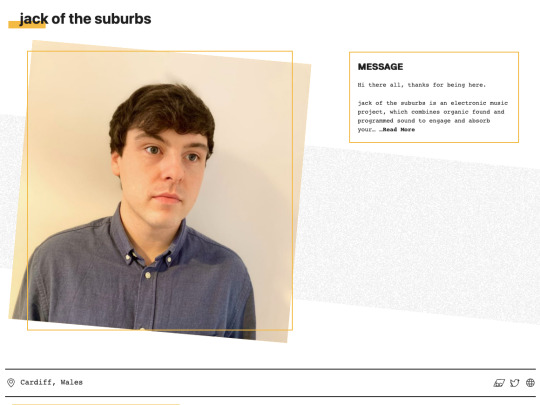
The final note about Ampled is that I met virtually with one of its co-founders, Austin Robey, to learn a little more about the platform and what a co-op was. I stumbled across Ampled through an article in the Creative Independent written by him, called 'How to start a cooperative'. This was super inspiring, and I was reading the article, it was describing all these things I wanted to get from this project. The call with Austin was also very helpful, and at that time it was also just really great having a conversation with a stranger. When I was discussing my vague plans for the project he mentioned that what I was describing was a co-op label - and told me to look up Dreams of Field Recordings...
Dreams of Field
Dreams of Field Recordings is an artist-managed cooperative record label run by The Hotelier, Emperor X, and other artists who join the cooperative. The label runs with the following three principles baked into their operations.
NON-PROFIT MOTIVE: 100% of the label profits must be reinvested into member-artists and their releases.
DEMOCRACY: Major decisions will be made by a board of all artists signed to the label on a consensus basis.
RANSPARENCY: Label financial statements, including a list of all label/artist revenue and costs, are available to the public above.
I watched their webinar which was livestreamed on Youtube, and now available on their website. They lay out how they intend to operate, holding their hands up to things they don't know, and give some links to organisations that explain the legalities of setting up a co-op (albeit in USA). They also mentioned that they wanted to see more co-op labels being set up and discussed the idea of them being connected via a co-op of co-ops. As if I could get a more direct sign to start a co-op label!
youtube
Spirit Level
Spirit Level don't really tie themselves down to the focused definition of a label anymore, and I'm not sure they operate as a cooperative, but they are certainly an artist-led collective that release music, and share many of the values that the other orgs liste above have.
Their 'about' is a click through list of statements about what they ARE and ARE NOT, giving a more mysterious and vague vibe about them. And beyond their music releases it was a little difficult to find out what they get up to, partly because they don't have social media accounts (hmmm, might check in with them about this). However I did find an article on Medium that did a kind of wrap up / look back to projects they have worked on and published. I really like their 'quiet' vibe of just getting on with doing stuff rather than shouting about it constantly. And they also work on projects beyond straight EP/Album releases, which is something Third Nature will encourage also.
As the use of platforms is so carefully considered at Third Nature, perhaps it may be important to create some sort of doc for prospective artists so they can understand why this is, explaining each of the platforms and how they operate.
0 notes
Text
The beginning of the major project story
In October 2020 I began putting ideas together for a project. Something that I wanted to last, become part of my life on a longterm basis; something I cared about. At the time of writing this (January 2021), I cannot for the life of me remember what those initial ideas were.
I had spent the summer reading and reflecting on my creative practice. The pandemic was going on way longer than I thought it would have and it had started to expose a lot of things for me that were just hiding from plain sight. I had many conversations with friends (Squad) over Zoom and ‘the group chat’ about internet cultures and the impact URL life is having on IRL life. Generally speaking we were finding the divide between the internet that we love, and the internet that was pissing us off, and trying to find out why we were getting so miffed about certain things.
We had been talking a lot about Spotify, about how we didn’t like the network effect it had over musicians to release music on there despite the remuneration system seeming so unfair. I use Spotify to listen to a lot of music, so there’s definitely some cognitive dissonance going on there. I get that it’s convenient for listeners. And I also get that getting your track in a popular playlist can get you loads of streams (and so maybe earn a bit of money). But as a group we reflected on the namelessness of this system. How easy it was to leave playlist running and not know who or what you are listening to even if asked. "Ah its on this playlist" was a phrase we discussed a fair bit.
You might argue that this system allows for greater music exploration, finding things you’ve never heard before. And you’d be right. But radio does this and I have no gripes with radio. What’s all that about? Artist and Computer Person, Elliott Cost wrote a short paper on the vastness of a website. In it he talks about how over the last few years…
"platforms have stripped away any hint of how vast they actually are. As a result, users only get to see a tiny sliver of an entire platform. There’s been an overwhelming push to build tools specifically designed for engagement (like buttons, emoji responses, comment threading) instead of building tools that help users actually explore. This has replaced any sense of play with a bleak struggle for users attention. The marketing line for these new tools could easily be, "engage more, explore less.""
He tries to combat this in the websites he designs by adding explore buttons that randomise content, for example. You can see this in action in a website he contributed to called the The Creative Independent.
"One thing we did implement was a random button that served up a random interview from over 600 articles across the site. I ended up moving this button into the main navigation so that readers could continue to click the button until they found an interview that interested them. It’s fairly easy to implement a “randomized items/articles” section on a website. In the case of The Creative Independent, this simple addition revealed how expansive the site really was.”
https://elliott.computer/pages/exploring-the-vastness-of-a-website.html
Sticking with the website theme, another thing we discussed as a Squad was the increase of Web 3.0 models in comparison to out current 2.0 models. We’d all done some listening to and reading of Jaron Lanier, who after writing a few books about the future of big data and the potential to monetise your own, eventually just wrote a really on those nose book about getting off social media. It’s called ‘Ten Arguments for Deleting Your Social Media Accounts Right Now’. To the point right? After feeling the negative effects of social media throughout 2018 and 2019, I’d reached breaking point, and this book tipped me over the edge to try going cold turkey. It was surprisingly easy and I loved being away from it all, especially Instagram. That app can do things to you. For quite some time I was obsessed over crafting the perfect post for my music and creative practice that I stopped making my core content to focus on keeping up appearances on Instagram.
I don’t think it works like this for everyone. Perhaps some people are more susceptible to the allure of its powers. Maybe it rooted in some insecurities. Either way, the network of people I was following and that were following me back were certainly not social. Our relationships were built on tokenistic and obligatory likes and comments. The FOMO was hitting hard and I wasn’t getting anywhere with my art and music.
I’m still off Instagram, all Facebook platforms in fact. I got rid of WhatsApp and forced my friends to use Signal. Cos that’s what you do to people you love, shine a light down on anything toxic in their life while sitting on that high horse.
I have returned to Twitter, months and months after being away from everything, because I’m trying to start a record label during a pandemic. You can’t meet up with anyone or go anywhere, how am I supposed to do guerrilla marketing if everyone is staring at their computer at home everyday? I could’ve come up with something online perhaps, and perhaps I might still. But for know I’ve jumped on Twitter and am just following everyone in Cardiff involved with music. I’m playing the spam game until we can go outside again. Then I’ll delete that little blue bird from my computer again.
I appreciate that these networks are useful and convenient. And there aren’t any good alternative with the same network effect. But the thing that Lanier said that really struck me was this idea that there needs to be enough people on the outside of it all to show others that it can be done. So until something better comes along, I am happy to sit outside of it all. Jenny Odell is helping me through this with her book “How to Do Nothing.”
As we discussed this as a Squad we noticed that much of what we were talking about was about aligning your actions with your values. It’s something seemingly impossible to maintain in all aspects of your life, but I genuinely think the more you can do this the happier you’ll be. We do it in so many other aspects of our lives, I wondered why it was so difficult to musicians who hate Spotify to not use, or for those riddled with anxiety to not use Instagram.
I think a huge factor of this is down to that word convenience again. Now, convenience is king. But, “At what cost?” I will ask. For every few seconds shaved off, kj of energy saved, or steps reduced in completing a task or getting something, there are hidden costs elsewhere that the consumer doesn’t have to worry about. And I think this is worrying. Not that I think things should be deliberately inconvenient for people. But on reflecting on this, I am happy for things to be a little ‘anti-convenient’. For processes of consumption and creation, to have that extra step I do myself perhaps, or for it to take that little bit longer for a package to get to me. Or even that I spend some time learning how to do whole processes myself.
Anyway, back to those Web3 chats…. the Squad noticed that the new Web seems to include glimmers of Web 1.0 and the return of personal websites, as well as newer ideas like decentralised systems of exchange. Artists that can do a bit of coding and seasoned web designers alike are creating an online culture that focuses on liberating the website and our online presence from platform capitalism. Instructions for how to set up your own social network (https://runyourown.social) are readily available with a quick search, and calls for a community focused web are common place from those dying to get off Twitter and live in their own corner of the internet with their Squad, interconnected with other Squads.
What’s this got to do with Third Nature? Well it means I decided to build our website from scratch using simple HTML and CSS. I intend to maintain this and eventually try to move the hosting from GitHub Pages over to a personal server ran on a Raspberry Pi. There is a link between the anti-Spotify movement and the pro-DIY-website culture, which is that ‘aligning your actions with your values’ thing.
Before Third Nature had a website though - before it was called Third Nature for that matter - I had this idea… What if there were an alternative to Spotify that was as fair as the #BrokenRecord campaign wanted it to be? I could so have a go at making that. Maybe on a small scale. Like for Cardiff, and then expand. After sharing the idea with the Squad though we did some research and actually came across a few music platforms that were doing these types of things.
More on this in the next post…
0 notes
Text
Interfacing
In the summer of 2020 I delivered a workshop as part of an artist residency programme called Restless Practice, led by the art collective,Site Sit (in collabroation with G39 and Kultivera). Restless Practice was an interrogation of the ecology surrounding productivity within artistic practice, where restlessness is characterised as both a productive and exhausting part of making.

Because of the lockdown restrictions during this time, for many movement was replaced with stillness, so the residency explored how the tools we have access to in our homes aid or hinder creative practice; how one could sustain their disparate networks; how slowing down could become a habit, rather than an emergency break; and what happened when travel wasn’t the solution to restlessness?
In addition to delivering the workshop I was asked to consolidate the activity and the learning gained from the residency into an accessible and useful public facing artefact. The ideas and questions that were explored throughout the residency resonated with me after my reading of ‘Against Creativity’, and considering how working from home increases precarity. I was interested to see how I could bring my experience with working with browser based tools and my refreshed appreciation for collaboration to offer some short and some long term solutions to the barriers created by remote working conditions.


I designed and created ‘Interfacing’, a digital and physical zine with an accompanyigin website, as a guide to working together while being apart. I thought the definition of the word interfacing, that is - to bring together, or connect - merged with the more contemporary use of the word interface, used to describe a Graphical User Interface on digital computers, captured the technological presence in human connection and communication at the time.

The zine includes fifteen headlines, each of them covering a different aspect of remote collaboration, with suggestions on how to organise joint work, and questions to consider about physical and mental wellbeing. The entries were written as poetic statements and questions, offering prompts and suggestions rather than instructions.
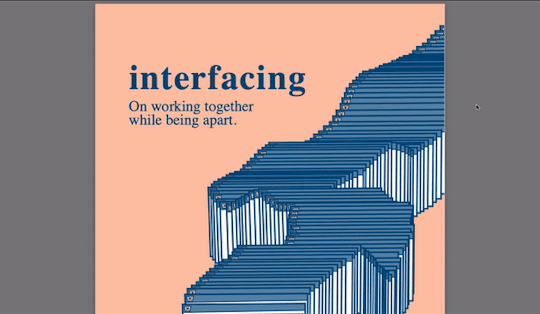
The process of creating ‘Interfacing’ itself was very collaborative, and some of the prompts and suggestions actually arose from the collaborative practices carried out during its own creation. There was a continual back and forth between myself and the artists in Site Sit, over video call, via email and shared documents. I presented design and content ideas, which were then honestly critiqued. I reflected on these ideas and either justified decisions or agreed with critiques and made changes. This process was repeated to ensure there was a true translation of the abstract outcomes of the residency present in the guidebook.

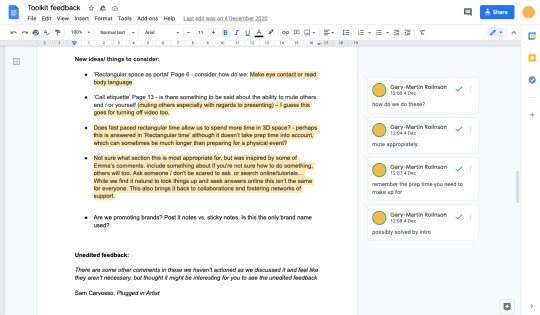
It was this collaboration, enabled by processes I had outlined in the guidebook, that made this project successful. This joint approach, while utilising each person’s strengths, made the whole greater than the sum of its parts.
It sounds like a very simple collaboration. And it was. But I have found this type of collaboration to be surprisingly uncommon when working with people and organisations in the creative industries, due to the “individualisation of creative labour practices, despite the rhetoric that it champions collaborative working.” (Mould, 2019) It was during this collaboration that I decided I wanted future projects of mine to be ‘truly’ creative and collaborative rather than have a "surface-level veneer of collective individualisation."
0 notes
Text
Criw Celf Workshop
Following from a workshop I delivered earlier this year, PEAK invited me back to take part in the Criw Celf programme, this year a little later in the year than usual due to the Covid-19 restrictions. This year’s programme was to be hosted remotely via workshops over Zoom. I had been asked to deliver the final workshop that would act much like a celebration event for the series of workshops that ran throughout the week. It would also provide the opportunity for the young people to engage in some activities that focused around using digital tools, as all of the other workshops were centred around more traditional craft-based practices.
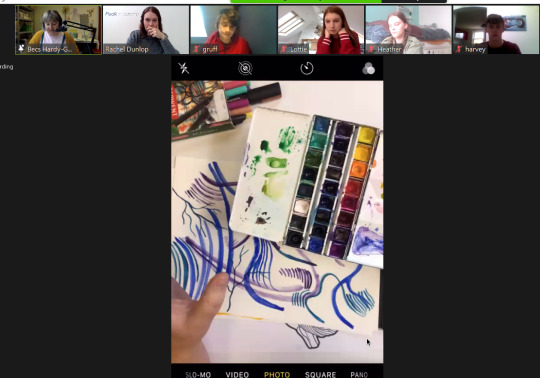
This thread of communication between myself and PEAK (Rachel Dunlop in particular) has developed over the past couple of years; these most recent workshops I have been asked to deliver have been direct developments of my recent practice exploring creative works exploiting affordances and limitations of internet platforms, most recently my live performance event, cul-de-sac festival, hosted on Zoom.
Over the course of a couple of weeks via our email thread and a couple of virtual coffee meetings, I developed a workshop plan in collaboration with Rachel and Carlota Nobrega, an artist based in Cardiff and part of the artist collective, Rat Trap. Carlota was doing some work with PEAK on this programme.
The main challenge in designing the workshop was trying to think about ways we could incorporate the works that the young people had already created, despite them being with them in their homes. Another barrier to ensuring a smooth delivery and engaging experience, was figuring out the lowest common denominator of computing device the young people had access to. For those that didn’t have access to a device suitable for the requirements of the session, an Android tablet was available to be sent to them from PEAK HQ.
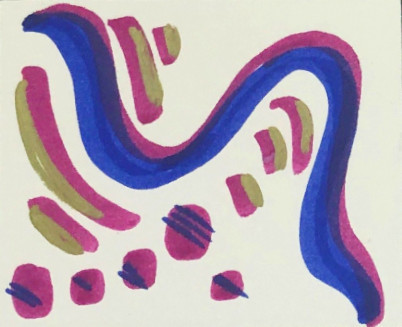
With devices varying in operating systems, ages and screen sizes, I decided to design the experience to be completely browser based, as access to a browser was the only thing all of the devices had in common. This gave me complete control in creating activities and experiences that I knew would work for everyone and that didn’t require downloading apps.
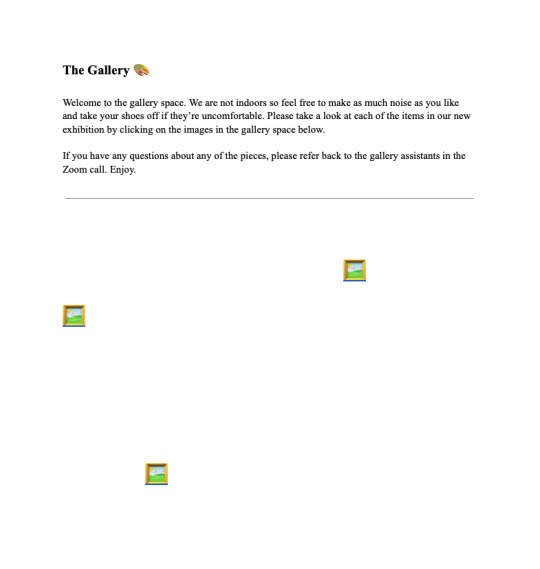
There were two main themes that came from the next stage of planning. The first was that the workshop was going to function like a digital scavenger hunt, where I would create multiple activities in different locations and link them together by leaving digital breadcrumbs. The second was that the activities would feature the existing work of the young people done throughout the week, which involved Carlotta curating images of the works into a single location that I could access. I then used these images, and thematic material I identified in them, as part of exercises that would allow the participants to digitally remix the works using bespoke coded programmes.
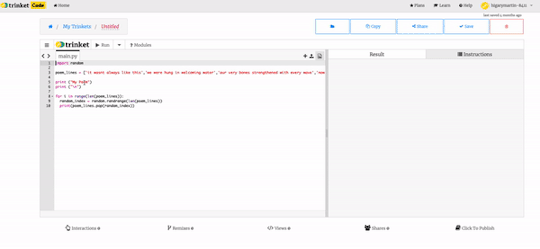

It was important that this session felt like a celebration for the participants as much as possible, as prior to the programme the participants had fed back that they were generally feeling unmotivated and were in low spirits due to the isolating impact of the national lockdown. I designed the workshop to be a kind of digital treasure hunt, where the participants moved through a series of online documents and had to follow instructions on how to get to the next activity. Each activity approached a different digital art making process using browser based tools and included the reworking or remixing of images and text that the participants had created in the previous workshops throughout the week.
At a time when spirits were generally quite low this session was a great mood booster because of the celebaotry nature and becuase of the intimacy of the social gathering. But from particiapnt feedback it was also a great in showing how you can still be creative and make things with others while we are so disconnected physically.

It was this feedback that gave the me the inspiration to carry out my next creative project, while I'll discuss in my next post.
0 notes
Text
creating a process-folio
In an effort to encourage people to consider alternative platforms fo hosting media/content/social updates, I’ve created a quick guide on how to set up a process-folio/blog using Tumblr. It’s been around a while, but social networking site these days don’t require customisation beyond adding a profile picture so blog platforms can feel fiddly if you’re not used to them. Anyway, here’s the setup and follow up video.
vimeo
vimeo
0 notes
Text
strengths analysis
Okay, time to dig deep...
What are my strengths?
How do I find out what these are?
I have to be careful here - make sure I’m not putting stuff down that I would like to have as strengths. That is so something I would do in my head.
Is that a strength? Self-awareness? It’s certainly something I’m good at, being self-aware.Many of my heroes and people that inspire me come across as really self-aware. And I’ve always liked that quality in people. So for as long as I can remember I’ve questioned my actions, thoughts, and thought about how they might be perceived by different people. Is it useful though? I think being self-aware has taught me a lot about empathy. It’s helped me put myself in the shoes of others, which is something else I think I’m pretty good at doing. And I definitely think that is useful.
Strengths strengths strengths...
Strengths are things that I am good at. But are also commonly agreed to be useful or beneficial qualities in certain contexts. And the usefulness or value of these qualities will depend on the context.
Here are some things I think I am good at, and that I think have benefitted me in the world of work and in being a happy person:
- I am very self-aware. I spend time trying to understand my thoughts and actions, my role in the world, and how others may perceive me.
- I am empathetic. I think a lot about the feelings and perspectives of others.
- I often procrastinate, which is where a lot of my learning takes place, going slightly and sometimes completely off task by side roads that take my interest.
- Which means I have got used to working under pressure. And am generally very good at this.
- I am good at working with others. In fact I thrive in collaborative contexts when it comes to working towards a productive outcome.
- I am good at being on my own. I enjoy my thoughts and my own company.
- I am a good listener. I enjoy hearing how and what people think, and how they express this, whether that’s verbally or through body language.
- I am playful. I enjoy creating environments where I can enjoy myself, and spontaneous silliness. I like making the ordinary feel extraordinary.
- I understand that working hard is important. I don’t always enjoy working hard, but am persistent to get things done that need doing. And I enjoy the feeling after completing hard work.
- I am able to take the lead of tasks and groups when needed. When I do I acknowledge that this role is just as important as every other role, no more no less, just different.
- I am good at explaining things to people. Given some time to prepare the most useful language and format for the audience, I am able to present ideas to people in easy to understand and engaging ways.
- I am inquisitive. I question everything, sometimes just for the sake of thinking about other perspectives. I love learning, and finding out how things work. I ask ‘what if’ questions a lot.
- I am good at communicating with others, and adaptable with my manner to speak to all types of people. I find it easy to express myself in writing and verbally. Although, I sometimes need time to formulate my thoughts; I like to be careful with the words I say. I’m aware I won’t always be afforded this time, and so sometimes I’ll say something vague or neutral, or little at all (which I’m aware may come across awkward or even rude perhaps), and would rather sit in silence while I think about responses to things. And fortunately I am able to do this around those I feel very comfortable with.
- I am getting pretty good at doing nothing. I have had to learn to take time for self-care and maintenance; my experience living with arthritis has forced an awareness of the relationship between mind and body, and that looking after them both is really important.
- I am interdisciplinary artist, and desgin creative experiences. Which means I can make a well educated guess what makes an enjoyable, engaging experience, and utilise a variety of tools and creative processes to design and materialise the environment or stimulus for these experiences. I have a sense of aesthetic awareness that I have worked to develop through my personal and professional practice and research. This allows me to appreciate and create artistic works in a variety of mediums, expressing myself, and ideas and themes from my own perspective.
I’ll think I’ll leave it there... I’m off to make a cake, which I’m pretty good at doing also.
0 notes
Text
sharing the learning: workshop with Peak
Closely following the cul-de-sac event I was contacted by Rachel at PEAK, asking if I would be interested in delivering the ‘pilot’ session for the YP programme they were developing and trialling.
This idea was something that was discussed in my studio visit meeting, but at the time I think PEAK were reluctant to try to move their summer programmes to an online format, as the idea conflicted with so many of the goals and aims of the organisation.
However, due to increasing concern of lack of contact they were having with the young people they work with so often, it was decided to try and develop a bespoke programme to allow the young people to be engaged with things and have contact with people they were so used to working with.
In my studio visit meeting, I shared my ideas for using Zoom as a platform to be creatively explored for sharing works and collaborating. It was this idea that Rachel felt would be a good idea for me to base the session around - meeting on Zoom and carrying out creative activities exploring its affordances.
Having helped develop the ideas that became the performances for cul-de-sac festival I now felt in a really good position to create ideas of my own that encouraged participation using the platform.
I was also really keen to use this opportunity to reflect and build on the sessions I had delivered to my Popular Music students, which were developed by adapting previously existing sessions, in slightly more uncertain and stressful circumstances (because this came as a surprise and was, as we all say now, ‘unprecedented’).
With a couple months of familiarity of using the tool to communicate with people in various contexts, I was able to consider its limitations as part of the planning process, and incorporate its affordances as part of the creative activities.
Preparation
I began by making a list of affordances that Zoom has (by no means a complete list!). Then I narrowed down this list to a few that I found more interesting or most used to exploit to create artistic processes around considering the limited resources the young people had: a sketchbook and the device they were using for the call. So in the spirit of Steal Like an Artist, I chose works that had recently resonated with me that lent themselves to be adapted really well in the virtual chat world.
Activity 1
Rationale
The inspiration for the first activity was a piece called ‘I heard that was a secret chord’ by Daily tout les jours, an art and design studio who create collective experiences for public spaces. I saw and heard the installation at an exhibition called 24/7 which I visited earlier this year. It’s an enclosed space with a looped recording of a group of people humming to the tune of ‘Hallelujah’ playing. There are microphones hanging down from wires, which you are encouraged to hum into, joining in with the recording and participating using your voice. Humming, as opposed to singing, removes a potential barrier to entry for participation: embarrassment. Humming is easy to do without worrying about ‘sounding good’.
Design
For this session, the idea was to play this loop through Zoom so everybody could hear it, and then for people to join in with the humming as a performative experience. And because all audio produced by participants funnels into your headphones, you lose the ability to locate the source of a sound through directional and spatial clues. And as humming gives less clues about the unique timbre of your voice, over Zoom humming enhances the idea of anonymity while being able to produce a musical sound.
Execution + Reflection
The participants were uneasy to begin with, as expected. But after a single round of the loop playing, I heard other voices come in. As expected it wasn't possible to identify who was humming from audio alone. It was possible to see people moving up and down, where it was clear that those humming physically moved with the rhythm of the humming. Participants admitted they felt much more relaxed to join in this experience than if I had asked them to sing.
Activity 2
Rationale
The second activity I based around the process of still life drawing, a process that is commonly taught at schools at different times, so I anticipated it to be familiar for the participants. The difference in this activity played with the idea of space, and its fluid nature while video calling people in different locations.
Design
I asked each participant to choose an item from their home and place it in full view of the camera, so there were 11 different items on the screen and no people visible. This presented the participants with a number of different objects to draw, where the perspective was the same for each person, as it appeared in 2D on their device screen. (Usually still life drawing involves taking a physical object(s) and centrally placing it for a group of people to see and draw from their own perspectives.) From here they were challenged to draw all of the items, using any preferred technical processes, and focus on the arrangement of the objects on their canvas. Here it wasn’t so much the detail or surface of the object they were trying to capture, but their interpretation of the scale, position, and proximity of the objects among one another. Something unique to using web conferencing tools for presenting objects.
Execution + Reflection
After explaining the instructions, the participants went out of full view and it was effectively silent for 10 minutes while people were drawing. This was something the participants enjoyed, as this was something they hadn’t experienced in a Zoom call before; the design of these tools encourage hyper-focus on the other people on the call, as you are ‘face-to-face’ with everyone in a conversation. It alleviated a pressure to make eye contact with someone and be more relaxed. The results were really diverse, as each participant had chosen a slightly different order to draw things in, how to scale the objects against one another and where to place them.

Activity 3
Rationale
The third activity I designed was based on the idea of a video performance by Koki Tanaka. It also draws on a philosophy of performance outlined in Performance by Anthony Rooley:
“...from birth to death, out entire 70-year span… is nothing, but nothing, other than a play, a performance. … Every action, interplay of relationships, pursuits of all kinds can be seen as ‘performance’.”
“The experience of performance contains such powerful things: heightened states of awareness, time seeming to stand still, comments of incredible clarity, moments of beautiful reverie, a sense of wonder, awesome beauty and love, profound admiration and respect. These brief, intense moments become magnified in an artistic ritual experience which is out of the ordinary. But all these delights are also to be found in the ordinary - if only we will let the natural thing happen, and not block it with negativity, boredom, habit and other abuses.”
These ideas champion embracing the playful potential of performing with everyday objects, a consideration that needed to be made due to lack of resources of the participants.
Design Participants were going to be asked to leave the Zoom call running, but go on an adventure to record the interaction of an object that exploited one of its affordances but that didn’t fulfill its intended function or purpose (like pushing a roll of toilet paper across the floor). These were then to be stitched together and screened as a single video.
Execution + Reflection
Unfortunately, we didn’t have time to fit this activity in. But it was explained to the participants and is something we are aiming to achieve remotely and watch together at another session in the near future.
Overall Reflection
The workshop finished with thanks from everyone, to everyone that was involved. I chatted with Rachel afterwards about the experience and we discussed whether the dynamic of a workshop over Zoom was effective. We agreed that it can and does work in the short term, as long as the restrictions are acknowledged as part of the workshop itself. Otherwise, common characteristics for workshops, such as intimacy, social connection, comfort, the ritual and sacredness of space, are completely lost and the experience could feel very dry.
This experience has only confirmed my thoughts that these conditions (the nature of video calls and the varying tools that enable it) for social interactions are not fit for purpose for the long term, considering our existing expectations of social connection, collaboration and participation. They are a temporary solution that serves practical purposes of convenience. But, ultimately they cannot, and I think should not, replace meetings in physical spaces for the sake of convenience in the future as we re-emerge post-lockdown.
And while I think the creative/artistic works being made within the limitations of the lockdown show resilience, flexibility and adaptability of people, for me these efforts are overshadowed by the sheer scale of the impact that has caused these creative restrictions in the first place. I’m aware this may sound a little defeatist and pessimistic, and possibly even undermine some of the really great things being made at the moment as a coping mechanism for individuals and communities, but I think a part of me resents that certain parts of society have had to ‘keep going’.
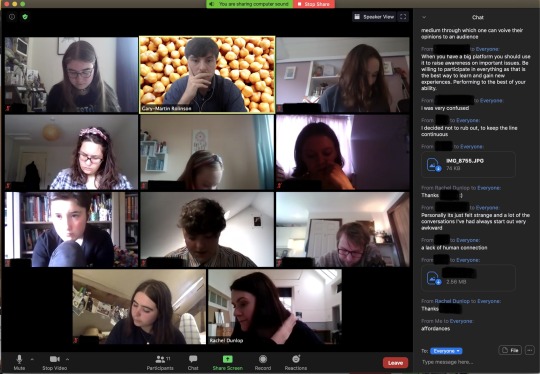
0 notes
Text
cul-de-sac festival: reflections and feedforward
So I did it... or rather, we did it! I must admit, I was a bit of a nervous wreck throughout the event. I’ve stood at the front of classrooms full of both children and adults, led workshops and hosted installations, so public speaking is something I'm quite familiar with, so I'm not completely sure why I was so thrown by this.
Part of it was obviously down to the stakes; let's face it I wanted and needed this to go well because it's for an assessment. But I also wanted this to go well because in that Zoom chat, were the vast majority of people I identify as being part of my local/regional network. And this is the largest public thing, and arguably most interesting, that I have done by myself (as opposed to with pyka, as a team). Which brings me to my other hunch; all the responsibility was on me here. There was no-one to share the nerves with, despite having collaborated with all the performers - they had there own thing to focus on!
Was it successful? I've been thinking about the idea of success for while now. I remember in one of our first sessions in semester 1, we were asked about our definition of success. Which I really liked - it made me feel like my own success criteria was valued, which I feel is a rare feeling, ironically in our individualistic society. There's a lot of lip service around the idea of one determining their own ideas of success, but this question felt genuine, and has slowly started to have an impact on the design of my projects on a long term basis.
In the creative industries, so often freelance practitioners have to chase the closest carrot to them to get funding (for projects that are having an increasingly shorter turnaround time but expecting larger impacts for the community/organisation). And this makes it difficult sometimes to take the time to ensure you're even chasing the right carrots in the long run. Because if you're not careful [insert clever carrot pun] one can end up taking on projects that seem exciting in the short term, but are not necessarily aligned with the core aspects of your practice. I mean, I can't be the only one that feels this, right?
How does this tie in to success? Well I have certainly started projects because I've craved short term success, which sometimes has just been likes and comments; the millennial's favourite source of dopamine. And in honesty I think focussing on producing these short term works has held me back and prevented me from developing longer term strategies for my practice. Something I am certainly not going to be doing again if I can help it. I've decided that now this event has passed, I won't be saying anything publicly until I've figured properly what it is I have to say. I'll come back to this shortly though.
Now though, let's take a look at some quantitate data, beautifully presented in the form of a gif I shared on Instagram as a look-back of the festival for those that attended and performed. It also allowed me to thank everyone involved

For me the only number worth discussing is the 44 attendees, which included many of the performers. As I officially started the event and commenced the Zoom call, I was wondering how many people would be logging in to join the experience. Before long I had 44 people logged in, and to my surprise that number remained the same right until the sign off for the end of the event. Now, this doesn't necessarily mean every account logged in had a person engaged the entire time; those with their cameras off could easily have got bored and wondered off but remained logged in out of politeness. But it felt like a big number, considering the aim of the event was to provide an intimate experience. In fact, had it got beyond 60 capacity (I thought half way through) this might have been too many.
The 44 mark felt really nice, but it was the fact that they stuck around for the whole thing that was more important to me than the number itself. This suggests to me that the event achieved its other main goal of being engaging for people. I also had a number of really lovely messages from people after the event, some from people I knew and some that I didn't, that confirmed this further. In a time when people have denied access to their usual means of socialising and sharing works, this event seemed to be a good substitute utilising the resources available.

I guess the other measure of success for this event is the impact it has had on my own thinking and approach to my future practice. I have spent a lot of time on social media platforms over the past few months, researching other artists, learning about their mechanics, affordances and limitations, and how they facilitate communication between people.
To keep a very long story at a moderate length, I have come to the conclusion that social media platforms are REALLY badly designed. Or, more accurately, they have clearly been designed and iterated with advertisers and those that profit from them in mind. Surprise surprise! This of course sounds completely obvious, and I've known this for a while, but until now I have been completely complicit of them because I felt I had to for the success of my career.
During this semester I have stumbled across alternative social media platforms that exist on the periphery of the internet, like Yap.chat, special.fish, and Mastodon. And comparing these to the likes of Twitter, FaceBook and Instagram, you can clearly see that these have been designed and maintained with the user in mind.
Instagram, for example, encourages you to be a prosumer; post content and consume content. And see it ALL in one feed. Whether that's photos of cats, brunch, a visual artwork, satirical meme, performance video, event poster, advert. They all come through one funnel, and therefore presented as equal. A cluttered highway of a mixture of content from people you may or may not actually want to follow (but have done so to reciprocate a follow). Doesn't this all sounds very messy? And what do I post? My food, my pet, my artwork? Do I keep it casual and share my process, or do I use this as a gallery and show my best work? Do I need to share anything at all? Well no, but that + button in the middle of the screen make me feel I ought to. And if I don't then how will people still know I'm an artist?
etc. etc........
These are genuine thoughts I've had recently and quite frankly I've had enough. I'm tired of living my 'personal' life so subconsciously strategically in an effort to be perceived as actively doing stuff all the time. And I know no-one's asked me to do this, but it's happened to me gradually as social media platforms play increasingly important roles in networking for people in the creative industries. Particularly individuals who consider themselves freelancers and rely on these platforms to share what they're up to, and send gentle reminders (in the form of likes and comments) to others that they are still around.
Carrying out this project has been super helpful in making me realise that I need to focus on working on projects that contribute to MY idea of success in the long term, and the small steps I take in that direction don't have to be celebrated publicly. It's easy to look at someone I admire like Louis Cole and get trapped into aiming for the type of success he has, because he's in show business and there are superficial markers for this success.
But when I finish this MA programme, I want to be ready to carry on my practice in a sustainable way. Had I not done this project, I may very well have continued to work on future projects because they seemed 'cool' or been successful at a superficial level.
I've realised that community and collaboration is really important to me and my practice. I have little interest in doing things unless I'm doing them with someone else, and for someone else. And I don't think social media platforms like Instagram and Twitter are going to play a significant role in achieving this.
I'm aware this sounds like the rants of a techno luddite, but I'm actually feeling 'optimistically realistic', and more than ever appreciate digital technologies as tools for enhancing human experiences. I'm genuinely very excited to begin planning my major project, with a new set of skills as a systems thinker, and designing meaningful experiences with and for people, with a focus on why I do it rather than what I'm doing.
0 notes
Text
cul-de-sac lookback
youtube
Here’s a lookback video I whipped up for the event, taking a snippet of each of the performances and giving a summary of my aims. Music is from the performance by Duelling Ants.
0 notes
Text
prototyping: experience design
So over the past couple of days I've been collaborating with the performing artists on their performances. Below is a description of each of the performances and a summary of the iterations that took place.
Just as a reminder of the brief the artists were given:
Create a performance between 5-10 mins that explores and exploits the affordances and limitations of Zoom (video conferencing) as a platform for ‘virtual gigs’. This is fairly open-ended, and I encourage you to interpret this brief any way you like to fit your practice.
Josh Wayles:
I got in touch with Josh after seeing him perform at a Utilipub event. To me he seemed keen to experiment in making works for the platform and had a great electornic sonic aesthetic.
The initial idea that was worked on was based on performing a piece live using Garage Band instrumentaion to produce sounds. Josh was keen to incorporate an interactive element so started to brainstorm ways in which the audeince could inform the music. Josh didn't want this to be to intrusive or pressured so we cam up with the idea to manipulate musical elements based on the visual movements of the audience. Like a live grpahic score, the audience would move naturally, or deliberately (they were told about this system), and Josh would use these movements as prompots to make changes in the performance.
Rosey Brown:
With Rosey, our discussions were less about me helping with the content itself, but explaining further the idea of platform determinism and expectations for the brief. With lots of questioning from Rosey she realised that a submitting a pre-recorded video would be an acceptable form of live performance. She wanted to utilise the fact that she didn't have to speak to the live audeince like one is obligated to do in physcial venues. Instead overlayed on to a video of her singing folk-esque songs, was text. Writing about the impacts the lockdown has had on her, this allowed her to tell two stories at once, and communicate to the audience on her terms.
Sophie Lindsey
Sophie's initial ideas bounced between sending in a video and performing live. 'Sourdough Karaoke' is an finctional online karaoke bar playing songs adapted to have sourdough related lyrics. Intially it was going to include low tech lyrics graphics appear at the bottom of the screen, but this was left out in the end to 'creqte a more authentic expereince for the viewers, who don't usually see the words when others perform.'
Duelling Ants
When I reached out to Hans, I was surprised to hear that he'd "never done live stuff before". This was interesting, as to me, most of his posts on Instagram were live performances, but just recorded and posted as videos. For him there was an extra level of immediacy and presentness (perhaps it was the element of risk), that meant he wasn't particularly comfortable with streaming him playing directly. In my initial messages I was trying to persuade him to play 'live', but for him it felt there were barriers that made him feel reluctant to do this (after many trials of a 'live' setup). Being one of the first acts I collaborated with, I'm glad I had this discussion around videos being a suitable format for performances for the event. We questioned what, if anything, would be lost by sending a video in rather than playing live. We came to the conclusion that the only thing you couldn't do was to incorporate certain interactive elements based on audience interactions. But this didn't matter for his performance anyway. This helped me view this event as a shared screening event, as whether or not you were performing 'live' or with a recorded video, people would be experiencing it via a screen anyway.
Teddy Hunter
The collaboration with Teddy wasn't as direct as most of the artists as we are chatting regularly at the moment, so these conversations informed the adaptation of one of her exisiting works.
Utililux
Similarly, I am having regular conversations with Jack at the moment, so collaboration with him is focused around tech support and details for the audience participation. We discussed the barriers to singing over Zoom, and I shared my experience with the humming installation 'I heard there was a secret chord' by Daily tout les jours. This allowed him to develop a karaoke expereince around whispering.
Onepan I learnt about Oscar's new midi controller, constructed from repurposed skateboards materials, through his Instagram account. He was sharing the making of it in his 'stories', and thought it would be a visually interesting tool to showcase at the event. We discussed camera setups that would best highlight the use of the tool on live feed, and he played original compositions which were visibly being manipulated by the controller. I actually thought this was a really great way of performing with midi controllers; my thoughts on laptop performances with controllers is quite mixed and have felt they lack a certain engagement from the audience as it's unclear how the sound they are hearing correlates with the visual gestures of the performer.
Brad Nath
I spoke with Brad extensively about his performance. He was another that was uncomfortable trying to transalte his practice (a form of ASMR performance, inserting contact microphones into domestic objects and sonically exploring its surface with touch) into a 'live' experience. This was mainly because he wanted to explore the idea of getting the audience to make sounds with their own household items. We decided to separate the two experiences to create a two part performance, the first being a bespoke video performance of him touching and scraping a loaf of sourdough bread, the second being a performer led, interactive ASMR experience.
Lauren Heckler The collaboration with Lauren explored figuring out the mechanics to create a 'gif disco' where she created gifs of the audience and presented them 'dancing' while playing disco classics. I suggested this being the final act, to give her time to collect images (secretly) and create the gifs, and then to play them (either as a video or by scrolling through a document) to allow people to see themselves. The disco music played, designed to make people dance, gave a background experience for people to enjoy while the watched the gifs appear.
Ffrwd
Admittedly, there was little collaboration required to organise Glyn's performance. He had an idea to play a recording of on a tape he had found but never listened to as a collaborative listening experience. He asked if this would be suitable and I thought it was really great. We sound checked together but I thought this idea didn't need further design to make this engaging.
Massa Circles
The Cardiff based duo live separately and thought this would be an interesting exercise in remote collaboration. We discussed how to adapt their usual modular synth live set up to work in this context, deciding that a performance of two halves that were blended together would work as another video performance.
Araby I've been chatting with David fairly often over the past few weeks and am aware his practice revolves around intimate storytelling, so the challenge here was to try and translate this to a video call experience, which we both considered much less intimate than a candle lit cafe sitting in leather armchairs. However, ever the optimist, David was up for writing a new piece of work for the event. A script that played on common experiences within Zoom calls. At last minute David was unable to do this 'live', so created a recorded version, which allowed him to utilise video editing to replicate delay and glitching of screens.
It's really turned out a bir thing There was little time to collaborate with this artist as they got back to me so late. However, having heard the proposal for the work, and with all the feedback from previous performers I was able to judge that what they had in mind would be fitting for the event.
learning notes...
For me one of the most interesting bits of learning from these collaborations, and messages from artists that didn't want to perform) was that many artists are very reluctant to take their practice into a 'virtual' world. And having learnt that many of the initial pop up virtual night clubs were made by web designers that had a friend who could do a bit of DJing, this made me feel quite relieved in a way.
I too massively resent that the world we live in currently is having to push a message of 'be fleixble and resilient to maintain relevant'.
So learning that other artsits felt this way was comforting, and actually made me much more sensitive in the way I approached artsits as I went through this process.
Another important thing for me to learn early on was that video performances were a totally valid format for performances, something I had not expected to be an outcome. There were are number of reasons people had for wanting to do videos, one being that some artists didn't want to comprimise the audio quality, especially if this was the focus of the performance.
0 notes
Text
prototyping: final line-up & poster
I have since confirmed another performer for the festival, and decided that an another event poster was needed that held all the information in on image, a reminder for people that were already aware of the festvial, and a teaser for those who hadn't heard about it yet.
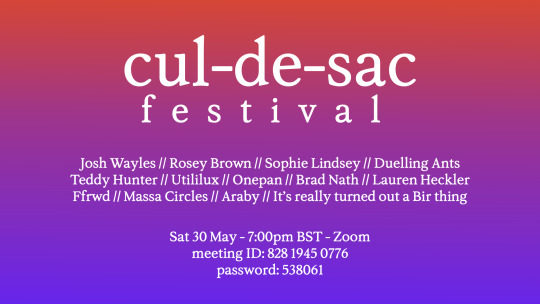
0 notes
Text
prototyping: cul-de-sac festival
After a really supportive response from artists that had started preparing their performances for the event, I decided to lean on some other skills in the interdisciplinary bag to ensure the event was marketed effectively.
I began with a name. Which came to me quite quickly. 'Cul-de-sac' has a number of interesting connotations that I thought suited the event well. Representing a dead-end, I felt (not to be too morbid) that I wanted to in some way, even subconscioulsy, acknowledge that at the moment people are going through pretty crap times.
It also represents community, and is drenched in traditions of neighbourly partying and celebrations, something I definitely felt was appropriate to try and capture. I really like exploring how the identity of social settlements define human behaviours and interactions.
Considering the network of creative practitioners, artists, and organisations has been built up through using Instagram, I decided that this would be the place that most of the marketing for the event would take place. As I have previously mentioned, I want this event to be intimate, so keeping this within a good size but tight knit network I have developed is the best way to ensure the right environment for the audience is formed.
Using my own concept of platform determinsim then, I had to ensure that marketing materials were simple and easy to read, striking, and also contain all the appropraite information. For the visual element I played with the colour scheme of Instagram itself to create a two-tone backdrop for clear white text.
I kept information simple. The name of the festival, the time and date of the event, the Zoom info, and a strapline. The strapline was really important for me, subtly empathising with people and suggesting this would be the last Zoom call they would need to go to - or even that this one would be so good, that all the rest would not be able to compare.
I employed some tongue-in-cheek marketing spiel to gain interest in the event by asking questions to the reader and encouraging them to swipe to the next image to read more.
Aware that you can't pin posts on Instagram like you can say on Twitter, or create an event like you can on Facebook, I created slightly different marketing materials and published them to these platforms also. Not that I am a big Facebook user (edit: I have since come off it altogether) or have a large following on Twitter (edit: off this now too) but I figured it wouldn't hurt to promote the event on these platforms. Admittedly I haven't put much thought in to this... have I done this because it just seems the thing to do?
I guess I was slightly concerned that if I only posted about it on Instagram once, due to the algorithms at play that determine the content that appears on people's feed, it may not appear, or people may miss it if they weren't browsing at the time I posted.
I drip fed a couple of posts on Instagram over the past few days which has had postive reactions in the form of likes and comments, and reposts on Instagram stories.
Below are the marketing materials used for Instagram:
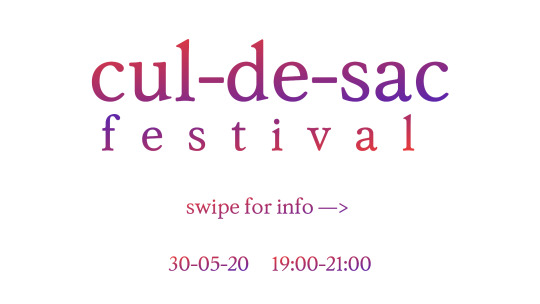
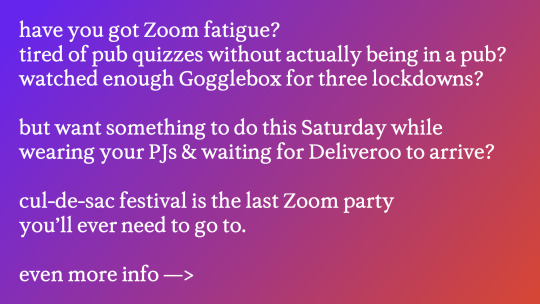

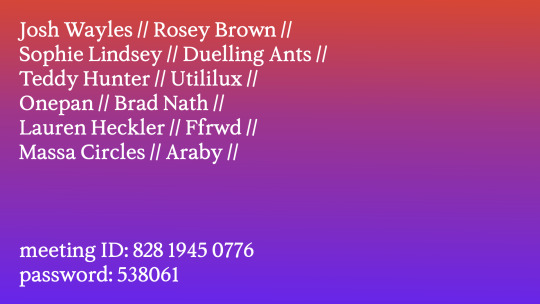
With an identity firmly in place, and this now feeling like a real thing, it's time to focus on devleoping the performances with the artists...
0 notes